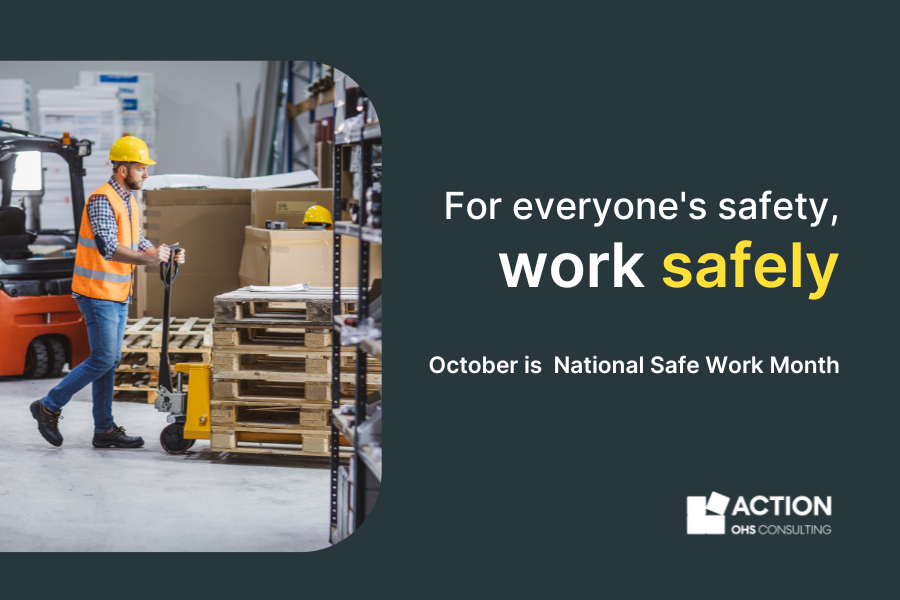The theme for national Safe Work Month this October is ‘For everyone’s safety, work safely’. In this blog, Principal Consultant, Christine Henaghan, shares her best practice tips for building a safe culture in the workplace.
One of the best books I have read regarding fostering safety and safe behaviour was following some leadership training. It’s titled ‘Safe by Accident?’ by Judy Agnew and Aubrey Daniels (2010), published by Performance Management Publications (PMP). The book explains the science behind behaviour-based safety and sheds light on why serious injuries and fatalities still occur at work, despite targets to reduce lost-time injuries. It provides a clear explanation of what influences safe behaviour and how to build a safe culture in workplaces.
In summary, the book emphasizes that our behaviour is reinforced or changed depending on the consequences we experience immediately after the behaviour. If the consequences are immediate, certain, and unpleasant, we are unlikely to repeat the behaviour. Similar to the pain of intentionally touching a hot stove. On the other hand, if the consequences are a mix of positive, immediate, and certain, as well as negative, future, and uncertain, the behaviour is likely to be repeated. An example of this is smoking cigarettes, which almost instantaneously releases dopamine in the brain, causing people to feel good, despite the risk of causing cancer.
As we observe Safe Work Month with the theme ‘For everyone’s safety, work safely’, let’s consider how we can foster immediate, certain, and positive consequences for safe behaviour among our workers to build a safe culture at the workplace. Here are some ideas:
Be visible and acknowledge safe behaviour:
While it’s essential to address unsafe behaviour, we should also focus on acknowledging and appreciating workers when they do the right thing. Just like giving a wave or a thumbs up when another driver merges before you in traffic, recognising safe behaviour can have a significant impact. According to Agnew and Daniels, specific feedback creates an immediate and certain consequence, reinforcing the behaviour. So, make it a point to approach and recognise those who follow safe procedures and training, and provide specific feedback and gratitude for their efforts. For instance, saying, “I saw/heard what you said/did (describe the behaviour), and I wanted to say, ‘Thank you’. It’s people like you who help keep yourself and others safe.”
Provide rewards for safe behaviour:
Consider implementing a reward system for safe behaviour, such as raffle tickets for a monthly prize or nominations for the employee of the month. Consult with your employees to understand what rewards might be valuable to them and make it happen, regardless of whether it’s a small token like a coffee or tea voucher, or a larger reward like donating to a charity of their choice or an extra paid day off.
Pay for safety learning:
Encourage your team members to participate in free safety webinars and seminars available on your local regulator’s website. Support their attendance during paid time and encourage them to share their learning with others in the workplace over a cup of tea or morning tea.
Personalise safety:
Engage with your team to identify potential sources of harm and implement better systems, processes, and controls. Encourage them to consider whether they would willingly send a family member or loved one to perform the tasks they are assigned. Recognise individual efforts in making the workplace safer during toolbox meetings or team gatherings.
Include safety in every meeting agenda and to-do list:
Make safety as important as accuracy, on-time delivery, and productivity by adding it as a regular agenda item in every meeting.
Small Businesses: Sign up for a free confidential gap analysis:
Small to medium-sized businesses (up to 60 employees) can take advantage of the free and confidential OHS Essentials program funded by Work Safe Victoria. This program provides access to an experienced safety consultant, who will visit three times for two hours each over 12 months, offering valuable guidance on workplace safety tailored to your specific needs. Register for your free visit here.
By implementing these strategies, you can promote a culture of safety in your workplace, where safe behaviour is recognised, encouraged, and rewarded. Remember, fostering safety is a collective effort that benefits everyone involved. Let’s work together to make our workplace safe for everyone.

